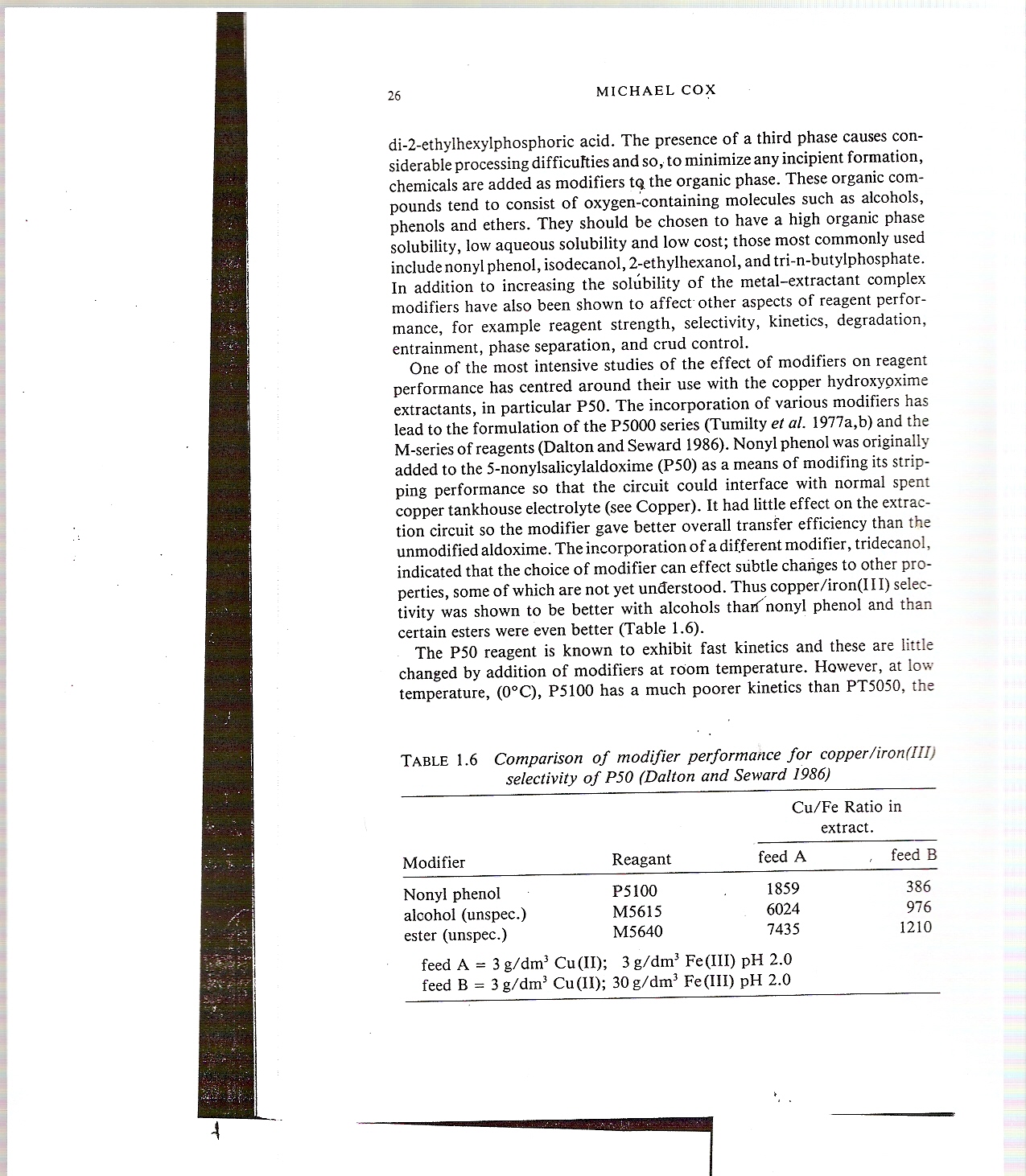scan0039 2

26
MICHAEL COX
di-2-ethylhexylphosphoric acid. The presence of a third phase causes con-siderable Processing difficufties and so, to minimize any incipient formation, Chemicals are added as modifiers tą the organie phase. These organie com-pounds tend to consist of oxygen-containing molecules such as alcohois, phenols and ethers. They should be chosen to have a high organie phase solubility, Iow aqueous solubility and Iow cost; those most commonly used includenonyl phenol, isodecanol, 2-ethylhexanoI, and tri-n-butylphosphate. In addition to inereasing the solubility of the metal-extractant complex modifiers have also been shown to affect other aspects of reagent performance, for exampie reagent strength, selectivity, kinetics, degradation, entrainment, phase separation, and crud control.
One of the most intensive studies of the effect of modifiers on reagent performance has centred around their use with the copper hydroxypxime extractants, in particular PSO. The incorporation of various modifiers has lead to the formulation of the P5000 series (Tumilty et al. 1977a,b) and the M-series of reagents (Dalton and Seward 1986). Nonyl phenol was originally added to the 5-nonylsalicylaldoxime (P50) as a means of modifing its strip-ping performance so that the drcuit could interface with normal spent copper tankhouse electrolyte (see Copper). It had little effect on the extrac-tion circuit so the modifier gave better overall transfer efficiency than the unmodified aldoxime. The incorporation of a different modifier, tridecanol, indicated that the choice of modifier can effect siibtle chańges to other pro-perties, some of which are not yet understood. Thus copper/iron(111) selec-tivity was shown to be better with alcohois tharf' nonyl phenol and than certain esters were even better (Table 1.6).
The PSO reagent is known to exhibit fast kinetics and these are little changed by addition of modifiers at room temperaturę. However, at Iow temperaturę, (0°Q, PS 100 has a much poorer kinetics than PT5050, the
Table 1.6 Comparison of modifier performance for copper/iron(III) seleclivity of P50 (Dalton and Seward 1986)
Cu/Fe Ratio in extract.
|
Modifier |
Reagant |
feed A |
feed B |
|
Nonyl phenol |
P5100 |
1859 |
386 |
|
alcohol (unspec.) |
M5615 |
6024 |
976 |
|
ester (unspec.) |
M5640 |
7435 |
1210 |
feed A = 3 g/dm3 Cu(II); 3 g/dm5 Fe(III) pH 2.0 feed B = 3 g/dm3 Cu(II); 30 g/dm3 Fe(III) pH 2.0
Wyszukiwarka
Podobne podstrony:
scan0041 2 28 MICHAEL COX For use as a diluent a liąuid should satisfy the following criteria: a wid
scan0031 4 18 MICHAEL COX 1.2.3 Solvating extractants In generał a soWating extractant tends to be r
scan0023 3 10 MICHAEL COX have an appreciable aqueous solubility, which can, under operating condi-t
scan0027 3 14 MICHAEL COX (p - n) R4N* Y" + MXjT«- ^ (R4N)p.łł(MXp) + (p-n)Y * (1.12) An altern
scan0043 2 30 MICHAEL COX hydrodynamic parameters but are difficult to set up and operate. Trouve et
F00574 024 f022a [AjDirect antiglobulin test (DAT) (Coombs test) Detects the presence of antibody bo
NOTICE Extension of Fees Payment for the UG-CW 2020-2021 The applicants of third allotment for the U
As every year the presentation of scientific abstracts (orał and posters presentations) will be the
7 thern soon finds out, detect the presence of a moving object at a distance of at least twenty feet
CCF20090225�138 Goffman E„ The Presentation of Self in Everyday Life, Garden City, N.Y., Doubleday &
99 difficult to observe by SEM the presence of Zn in the form of ZnO. Zn was highly associatcd to ir
DSC00902 (9) Tests for module 1 CSTboracic vertebrae are distinguished by the presence of: (UMsnCu.l
Speech timing problems Associated with dysarthria often involve the presence of periods of extraneou
87 Norway penetration are logged. The lower part of Fig. 2.1 demonstrates the presentation of t
więcej podobnych podstron